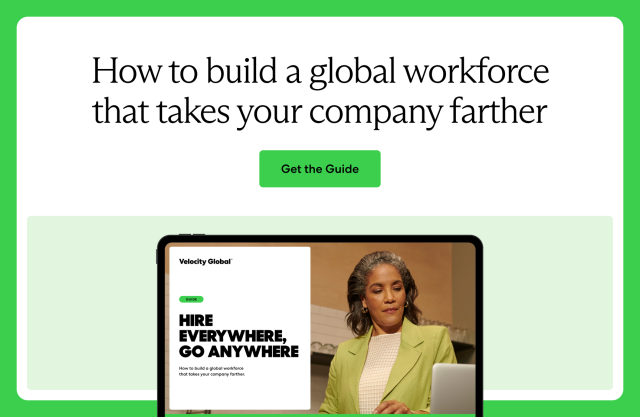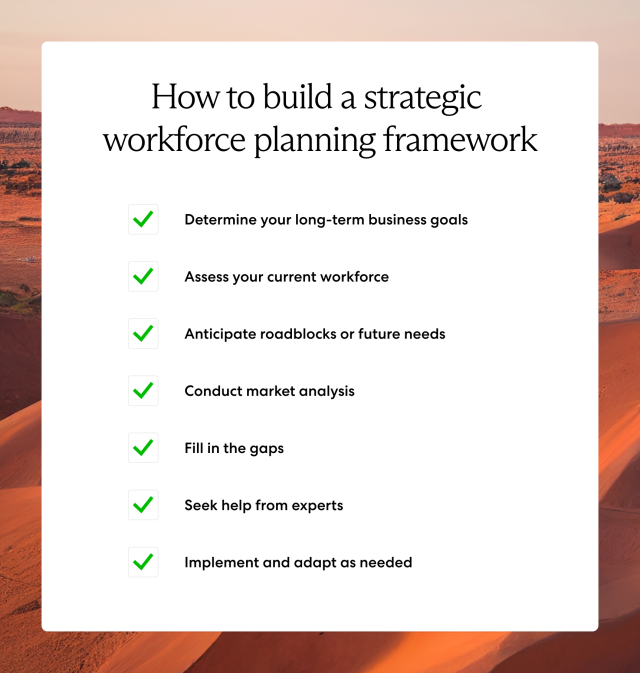To ensure sustainability in today’s evolving business environment, companies must incorporate strategic workforce planning into their overall business strategy for healthy growth and success.
Strategic workforce planning helps you assess talent and skills gaps, forecast workforce supply and demand, and ensure you have the right people to meet your long-term business goals.
The following guide explores strategic workforce planning, its purpose, importance, and best practices for maintaining an agile, compliant, and globally competitive workforce.
What is strategic workforce planning?
Strategic workforce planning is the process of analyzing your workforce supply and demand data and making necessary adjustments to support your business’s future needs and goals.
Workforce planning strategies ensure that businesses have the right people in the right jobs at the right time, with the skills and knowledge needed to meet current and future business goals.
Workforce plans set a team up to scale by addressing all internal needs and ensuring seamless growth. Companies anticipate future hiring needs and work to ensure the right people enter the business at the right time. They do this by identifying skill gaps within the workforce that may arise as the company grows.
After assessing its needs and strategic plans, a business uses strategic workforce planning to look at possible solutions to meet future growth goals and maintain a solid competitive advantage in the market.
The 7 Rs of strategic workforce planning
During strategic workforce planning, a company must assess where it stands as a business today, understand its current workforce, and be aware of what’s happening in the market. This knowledge helps a company create a strategy to achieve its long-term talent goals.
The goal of a workforce planning strategy is to have a workforce with the right people, skills, shape, size, time, place, and cost:
- Right people. New hires that are beneficial to the company and work well with the company’s culture, values, and needs.
- Right skills. New hires that have the right work experience and skill set to do their job correctly.
- Right shape. New hires help make up the right workforce configuration and competencies needed within the company in the short and long term.
- Right size. New hires fit the correct number of people and job roles so that a company’s workforce is not too small, unproductive, overstaffed, or inefficient.
- Right time. New hires or promoted employees can immediately produce work that furthers the company.
- Right place. New hires live and work in strategic locations to fulfill current and future operational needs and growth.
- Right cost. New hires are fairly and competitively compensated for their work and within budget.
The best way to find the right people with the right skills at the right time is to hire across borders. Incorporating global hiring into your strategic workforce plan empowers you to find candidates who check every box while maximizing your hiring budget.
Learn how to easily hire talent across borders, quickly expand your business into new markets, and ensure compliance for global talent in our guide:

Strategic workforce planning examples
A few examples of what strategic workforce planning might look like include:
- Putting together a talent acquisition strategy
- Planning for talent retention
- Developing new positions for future needs
- Developing leadership training
- Establishing global expansion initiatives
- Expanding operations, services, or products
- Creating career path development
- Forecasting market demands
- Initiating succession planning
- Maintaining global compliance with employment laws
What are the benefits of strategic workforce planning?
In today's dynamic business landscape, strategic workforce planning is critical for businesses looking to stay agile, resilient, and competitive. Strategic workforce planning has many significant benefits to organizations, including the following:
Alignment with business goals
When you understand your business needs and objectives, you can develop a roadmap and workforce plan that provides a path to achieving your desired growth. Strategic workforce planning ensures you align your workforce decisions and planning with your business goals.
Addressing current workforce gaps
A workforce gap is a mismatch between what skills you need from your workforce as you scale and what skills your employees possess.
Looking toward the future can help you identify critical skill gaps in your current roster. This keeps your organization on track to grow by focusing on recruiting, training, and retaining employees with those desired skills. Workforce planning can also help you ensure your current roster doesn’t become overloaded when expansion starts.
Cost reduction
Effective strategic workforce planning helps you hire the correct number of employees with the right skills at any given time, leading to financial savings. You can avoid costly overstaffing or understaffing situations by optimizing workforce utilization and minimizing unnecessary expenses.
Diversity and inclusion
You can use workforce planning to meet your diversity initiatives and create a more inclusive work culture. Strategic workforce planning enables you to promote diversity and inclusion by identifying opportunities to broaden the workforce with unique perspectives, backgrounds, and skills.
Risk mitigation
Strategic workforce planning helps you mitigate risks and proactively address potential challenges before they become critical issues. As you expand globally, you can utilize strategic workforce planning to ensure compliance with labor laws and regulations. Forecasting future workforce needs can mitigate potential challenges associated with talent shortages or skill gaps.
Preparation for the future
Workforce planning allows you to create a long-term strategy for the company well into the future of technological advancements, market fluctuations, or regulatory changes. Though unforeseen, you can better adapt and respond effectively to changes and challenges with a solid strategy. Once implemented, you can return to focusing on day-to-day tasks, knowing that your organization is ready to grow when the time comes.
How to build a strategic workforce planning framework
While the specific strategic workforce planning process will vary depending on the size of your business, industry, and market, consider the following strategic workforce planning best practices for building a framework and execution.

1. Determine your long-term business goals
Setting direct, actionable goals can help you determine how and who to hire as you work toward them. Your goals should focus on your most crucial business needs and help set a trajectory for your business's growth.
Most businesses follow a S.M.A.R.T. framework for goal-setting. That means the goals will be:
- Specific. Each goal should focus on one aspect of your business to make the objective direct and meaningful.
- Measurable. Tie a tangible way of measuring success to each goal so you can prove you’re making progress.
- Attainable. Shooting for the moon isn’t always the best option—your goals should be within the scope of your organization and within the designated timeframe.
- Relevant. Goals should align with your company’s business model, needs, and objectives to ensure you stay on track.
- Time-sensitive. Set goals within a specific time frame to keep moving forward and setting new objectives.
Leverage data analytics based on trends and business growth to help forecast your future workforce needs and enable you to set informed and effective goals.
Tip: Setting long- and short-term goals can help keep morale up by creating more opportunities to celebrate company wins.
2. Assess your current workforce
An early step to workforce planning should include assessing what you already have. Look at your current roster and identify strengths and weaknesses. Determine what is going well within your organization and how you can become even more vital.
Three central workforce issues should drive workforce planning: your strategic plan, outside factors changing your workforce, and maintenance of your current workforce.
- Strategic plan. Figure out how your workforce is meeting or not meeting your current goals and the steps to get to a point of satisfaction.
- Outside factors. Determine which external factors—like new competition, diversity initiatives, adopting remote work, or other factors—will affect your workplace.
- Workforce maintenance. Decide how to strengthen your workforce with better training, a new focus on employee well-being, or initiatives to boost employee engagement before you start looking to grow.
Keep a skills inventory to help you understand your current workforce’s experiences, skills, competencies, and qualifications. Determine the most critical roles that drive the most value and analyze the skills, knowledge, and qualifications that make employees successful in them. This will help you determine if there are current employees who can train for these roles or whether they are roles to hire externally.
Tip: Internal surveys can help you gauge your employees’ satisfaction while you work to pinpoint issues affecting your organization.
3. Anticipate roadblocks or future needs
The key to an effective workforce plan is doing guesswork to anticipate future needs or potential roadblocks. By planning for these in advance, you can be ready to meet them head-on.
Consider where you are now vs. where you want to be. How many staff members are needed to execute a project or meet a deadline? And if your business grows at the rate you anticipate, how many will you need in six months? If the projected number is more significant, you must ensure you have the staff to meet deadlines.
Tip: You can also gauge your current roster’s bandwidth and burnout levels to determine how many new staff members will keep the team productive while prioritizing their well-being.
4. Conduct market analysis
In addition to assessing your current workforce, it’s important to analyze the current market when creating a strategic workforce plan. Understanding the market and its labor trends will offer key insights into where your industry is heading and help you assess potential staffing needs.
Keeping an eye on emerging market trends on a global scale, especially in your industry, will help you understand what your business needs and how to prepare for it. Research international markets to determine where to hire foreign employees to help you fill gaps and scale as needed.
Tip: Consider engaging international contractors in your desired markets to test new countries and gain local insights before expanding and committing to a particular market.
5. Fill in the gaps
Once you know where you are, where you want to be, and any obstacles that might hinder getting there, you can fill in the gaps and finalize your workforce plan.
Identifying these gaps can help you fill roles with people who will support your growth. Consider engaging with skilled candidates and creating a talent pipeline of pre-qualified individuals you can consider for future open roles when needed.
Also, filling in the gaps can help determine whether you can fill the needs with more employees serving your current roles or if you'll need to develop new roles altogether.
For example, if you’ve been working as the boss with all of your employees as your direct reports, you may need to hire managers to act as middlemen so you can focus on other tasks and let them handle project management.
Tip: Once you feel like you’re never logging off, you should consider promoting employees to management positions.
6. Seek help from experts
Developing a relevant, efficient, and actionable workforce plan may not come naturally to some business leaders. Establish partnerships with key stakeholders that can help collaborate and assist you with rolling out a strategic workforce plan. Third-party organizations specializing in workforce optimization can also help you nail down your business plan as you scale.
Consulting an agency to help identify your workforce needs and assist in hiring for those needs can help you make sure you’re not only preparing yourself for the future but also setting yourself up for a successful one.
Tip: A third party is even more critical for those growing globally. Global employment organizations can ensure you comply with labor laws while selecting suitable candidates to support your growth.
7. Implement and adapt as needed
Just like an adaptable workforce is essential, so is a flexible workforce plan. Your plan might give you a solid trajectory for your growth, but that doesn’t mean you won’t need to make adjustments as you scale.
You’ll likely be confronted with situations and needs you didn’t foresee. While your plan will address the bulk of these needs, some needs that weren’t accounted for may arise. You may need to revisit and restructure your hiring plan in these scenarios.
Tip: Keeping track of your growth within your goals can help you pinpoint when you’re getting off track as early as possible.
Strategic workforce planning FAQs
The following information discusses common questions surrounding strategic workforce planning.
What is the purpose of strategic workforce planning?
Strategic workforce planning helps organizations ensure they have the right employees with the right skills, knowledge, and experience to meet current and future business goals. Workforce planning helps keep businesses on track to meet client and customer needs, effectively manage talent while optimizing labor costs, and accommodate future changes and trends.
What are the major objectives of strategic workforce planning?
The primary objectives of strategic workforce planning ultimately enable companies to successfully plan for the future and maintain a competitive advantage in the market. Some of these objectives include:
- Assessing talent and skill gaps
- Forecasting talent supply/demand
- Ensuring the business has the right people in place at the right time
- Preparing the business for unexpected events and changes
- Improving agility and adaptability in the workplace
- Mitigating risk while optimizing labor costs
- Adapting to new technology solutions and resources
- Exploring new untapped markets to meet future demands and expansion
Read more: How to Build and Manage a Remote Global Workforce
Simplify and scale workforce planning with Velocity Global
Strategic workforce planning is critical to meeting future growth goals and maintaining a solid competitive advantage in the market. Whether creating new revenue streams, hiring international employees, or entering new markets, a global workforce partner like an employer of record (EOR) can help you identify your needs and implement a long-term strategy for success.
Velocity Global’s personalized expertise and unmatched scale in over 185 countries can help you effectively plan for the future. Our industry-leading EOR solution, in-house capabilities, and in-country knowledge provide a quick, cost-effective, and globally compliant way to scale your teams.
Navigate new markets and facilitate swift global expansion with tenured HR and legal experts by your side. We’ll help you seamlessly hire and pay your distributed workforce and maintain compliance at every step—from onboarding to ongoing management and support.
Simplify your strategic workforce planning with Velocity Global. Contact us today.



